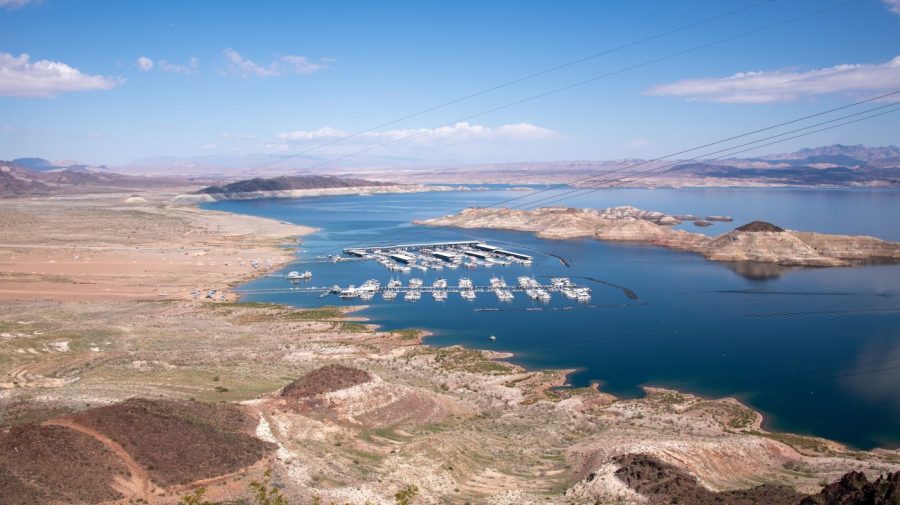Lake Mead’s level jumps 3 feet — but hope may be short-lived
After falling to record lows in 2022, Lake Mead has seen its water levels rise 3 feet above projections after a precipitation-heavy winter. But experts warn it’s only a temporary reprieve without a comprehensive water management plan.
While the Colorado River reservoir’s elevation was projected to sink to 1,043 feet above sea level by March, according to Bureau of Reclamation (BOR) data, it sat at about 3 feet higher as of Monday. Overall, the reservoir is about 5 feet higher than its lowest level ever measured, 1,040.71 feet above sea level, which it reached on July 27, 2022.
The higher-than-expected levels are largely due to the heavy levels of precipitation in the West over winter of 2022 and 2023, tempering the drought that has plagued the region for almost the entirety of the century. California was repeatedly struck by heavy rains and “atmospheric rivers,” while the Rocky Mountains, the starting point for about two-thirds of the river’s annual flow, saw above-average snowfall. In Colorado alone, federal data indicates that the Rockies’ snow-water equivalent was about 158 percent of its average for the time of year at the end of March.
This hasn’t been just any wet winter. Analysis by Weather Underground indicates March 2022 to February 2023 was the wettest March-February period in the U.S. on record and the third wettest 12-month period overall. Only 12 percent of the country was experiencing drought as of Feb. 28, according to the U.S. Drought Monitor, a six-year low.
“We had a really, really good winter here out west. In northern Arizona we had record snow on the ground,” Christopher Kuzdas, a senior water program manager with the Environmental Defense Fund, told The Hill. “I’m hopeful that we won’t have another terrible fire season,” he added, which would continue the positive trend.

However, Kuzdas said, the good winter should not be viewed as a blank check to avoid lasting water-management strategies for the still-overallocated Colorado River. “It means stay the course,” he said. “It would be irresponsible to do nothing just because we had a good winter.
“We’re going to see crazy good winters now and then, but that’s happening within the broader context of aridification,” Kuzdas said. “We can sit around and hope for five or six good winters but that’s not good water management, that’s just flailing around. We still have a huge underlying problem [and] we need action.”
The lake’s levels have been dropping since the turn of the 21st century, when a two-decade drought, exacerbated by climate change, hit the western U.S. Even with the recent weather, the lake is only about 28 percent full as of Sunday, according to BOR data. The lake, formed by the Hoover Dam, is the nation’s largest reservoir by capacity and has become symbolic of the once-in-a-millennium drought plaguing the region.
Wildfire season is another unknown factor when it comes to whether the positive trend will continue for the reservoir. Fires can have major implications for snowpack and thus water levels because they often destroy forest cover that would shield snowpack from direct sunlight. Compounding the risk, fires can leave carbon residue behind that, unlike snow, absorbs heat from the sun rather than reflecting it.
The National Interagency Fire Center predicts that in the Southwest, the wet winter will likely “have a limiting potential on the severeness of the significant fire potential for most areas this spring,” but adds “it’s possible that some areas west of the [Continental] Divide could see increasing significant fire potential by summer associated with the weaker monsoonal flow into this part of the geographic area.”
“When you have such years [as early 2023], it’s great because, in a way, they can provide some support, some backup for the environment and provide some sort of stress relief, but that doesn’t mean next year is going to be the same,” said Newsha K. Ajami, director of Urban Water Policy with Stanford University’s Water in the West program.

The West “swinging from one extreme to another” is partly indicative of climate change, Ajami said, and the “short-lived relief” from the winter “needs to be used very wisely and we need to adjust our policies to address this climate reality we’re facing.”
To that end, Kuzdas said, policymakers should be using the time bought by the winter precipitation to build back water storage, “not to take everything out of the river that everyone possible can.”
“Maybe this winter gets us another six months, maybe a year” before decisions must be made about allocation cuts, “[but] there’s still enormous need and pressure to come up with a long-term plan to use less,” he added.
Use of Lake Mead and the Colorado River that feeds it are governed by a 1922 compact that was itself based on unusually wet conditions. The seven states in the basin — Colorado, New Mexico, Utah and Wyoming, Nevada, Arizona and California — have yet to reach a new agreement, even with the federal government suggesting it will make the decision for them if they are unable to agree on cuts. The basin states reached an interim agreement in 2007, which is set to expire in 2026.
Copyright 2024 Nexstar Media Inc. All rights reserved. This material may not be published, broadcast, rewritten, or redistributed..











